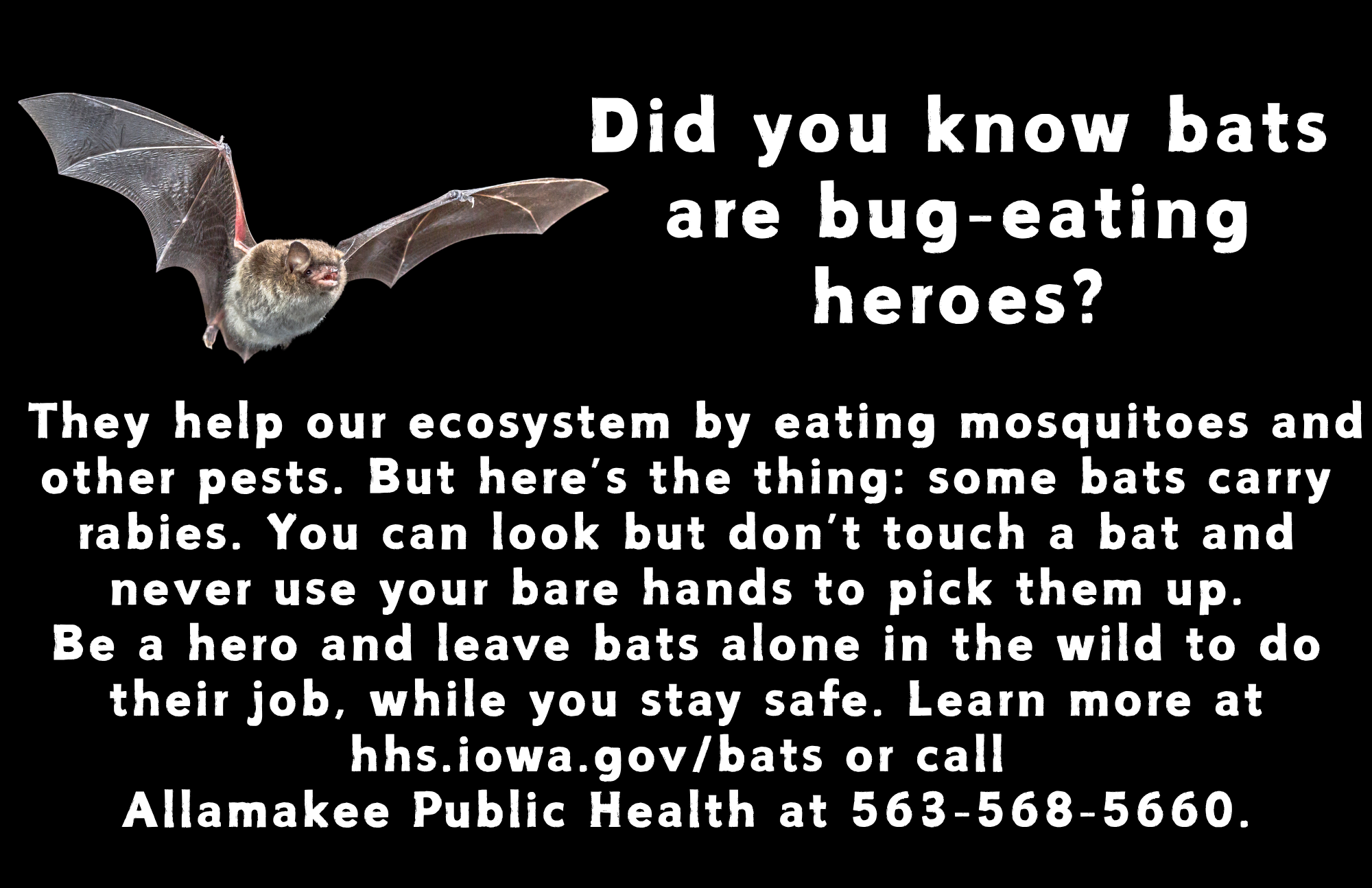What to do if A Bat is in Your Home

From the Iowa Department of Health and Human Services and Allamakee Public Health
More bats test positive for rabies yearly in Iowa than any other animal species. Bats are also the most active in our state during the fall as they search for places to hibernate for the winter. This is when most Iowans come into direct contact with bats, potentially getting exposed to rabies.
Not all bats have rabies, but it's important to recognize possible signs of rabies in bats. Unusual behaviors that could indicate that a bat has rabies include:
- A bat that is active during the day.
- A bat that is found in unusual places (inside a home or on the ground).
- A bat that is unable to fly or is easily approached.
Never touch a bat with your bare hands. If you see strange bat behavior, do not even approach the bat. If you are bitten by a bat, speak with your healthcare provider about shots (vaccines) to prevent rabies. A bat bite can be so small that it may be undetectable. If you don’t know if the bat touched you, your family or pet, then you are considered potentially exposed to rabies.
What to do if You Find a Bat in Your Home:
If there is any chance that a person or pet had contact with the bat, the bat should be safely captured, WITHOUT TOUCHING IT, and tested for rabies.
To safely capture a bat:
1. Close all doors and windows to prevent the bat from escaping.
2. Find a small container and a piece of cardboard large enough to cover the opening of the container. Punch small air holes in the cardboard.
3. Put on leather work gloves.
4. When the bat lands, approach it slowly and without touching it, place the container over it then slide the cardboard under the container to trap the bat inside. Tape the cardboard to the container, securing the bat inside.
5. If a person or pet had contact with the bat, the bat can be tested at two different Iowa laboratories. If a person had skin-to-skin contact with the bat, testing is available at the State Hygienic Lab at no cost OR at the Iowa State Veterinary Diagnostic Lab at the submitter's expense. If a pet had contact with the bat, testing is available at both labs at the submitter’s expense. If the bat is alive, contact a veterinarian to euthanize the bat before submitting it. If a veterinarian is not available to euthanize the bat, live bats can be hand delivered to both labs. Before transporting a captured bat, place the container with the bat in a second larger container (such as a cardboard box), tape the container shut, and write LIVE BAT on the outside. When dropping off the bat, tell the person receiving the bat that it is alive.
6. If you are certain there was no contact between the bat and any people or pets in your home, carefully hold the cardboard over the container and take the bat outdoors to release it away from people and pets. Remember, bats cannot take flight from the ground, so they may need to climb to an elevation to fly. However, during the winter, consider reaching out to a licensed wildlife rehabilitator.
Bats do not chew their way into buildings, but can squeeze through a hole as small as a dime! Keep bats out of your home by fixing torn window screens, broken siding, loose shingles, missing or broken chimney caps, and fill any holes around your home that lead outside. Exclude bats by watching where they exit the building at dusk, then hang a flap made of clear plastic sheeting or bird netting over these areas. Bats will be able to leave, but not re-enter the building.
For more information, please contact Veterans Memorial Hospital Community and Home Care-Allamakee County Public Health at 563-568-5660.

